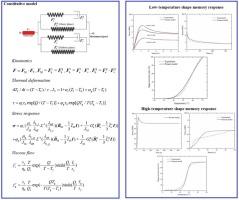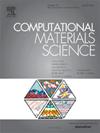A unified thermodynamic modeling approach for amorphous shape memory polymers
IF 3.1
3区 材料科学
Q2 MATERIALS SCIENCE, MULTIDISCIPLINARY
引用次数: 0
Abstract
The programming of shape memory polymers (SMPs) for use in large-scale space structures and implantable medical devices is a process that is currently time-consuming, labor-intensive, and energy-intensive, particularly when carried out at high temperatures. Fortunately, SMPs can usually be induced to produce shape memory effects not only at high temperatures but also at low temperatures, which makes them a hotspot in the fields of biology, medicine, aerospace, etc. However, few studies clearly present a unified method for modeling the shape memory characteristics across disparate programming temperatures. In the paper, we develop a unified thermodynamic modeling approach for SMPs. The free energy is decomposed into a rubbery part and a glassy part with the introduction of the phenomenological theory. Consequently, the complex structure and stress relaxation mechanisms undergo significant simplification and innovation. The fully thermomechanically coupled constitutive equations are derived from the second law of thermodynamics. Subsequently, the constitutive model is employed to reproduce the shape memory effect (SME) under both high-temperature programming and low-temperature programming. The model findings are effectively compared with the thermo-mechanical experiments, resulting in a good agreement.

非晶形状记忆聚合物的统一热力学建模方法
目前,将形状记忆聚合物(SMPs)编程用于大型空间结构和植入式医疗设备是一项耗时、耗力和耗能的工作,尤其是在高温条件下进行时更是如此。幸运的是,SMP 通常不仅能在高温下产生形状记忆效应,还能在低温下产生形状记忆效应,这使其成为生物、医学、航空航天等领域的热点。然而,很少有研究明确提出一种统一的方法来模拟不同编程温度下的形状记忆特性。在本文中,我们为 SMP 开发了一种统一的热力学建模方法。通过引入现象学理论,自由能被分解为橡胶和玻璃两部分。因此,复杂的结构和应力松弛机制得到了极大的简化和创新。热力学第二定律推导出了完全热力学耦合的构成方程。随后,利用该构成模型再现了高温编程和低温编程下的形状记忆效应(SME)。模型结果与热力学实验进行了有效比较,结果一致。
本文章由计算机程序翻译,如有差异,请以英文原文为准。
求助全文
约1分钟内获得全文
求助全文
来源期刊

Computational Materials Science
工程技术-材料科学:综合
CiteScore
6.50
自引率
6.10%
发文量
665
审稿时长
26 days
期刊介绍:
The goal of Computational Materials Science is to report on results that provide new or unique insights into, or significantly expand our understanding of, the properties of materials or phenomena associated with their design, synthesis, processing, characterization, and utilization. To be relevant to the journal, the results should be applied or applicable to specific material systems that are discussed within the submission.
 求助内容:
求助内容: 应助结果提醒方式:
应助结果提醒方式:


